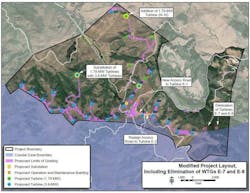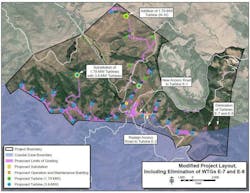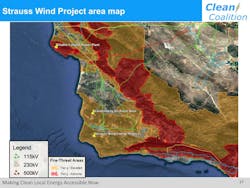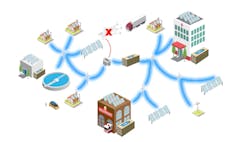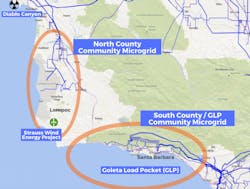Santa Barbara County ranks low among California’s 58 counties in renewable energy generation, despite its distinction as the birthplace of the environmental movement in the 1970s. But the county is on a path to change that status with the upcoming Strauss Wind Energy Project (SWEP), a 98-MW wind farm to be built just south of Lompoc by an affiliate of BayWa r.e. Global. The SWEP was unanimously approved by the Santa Barbara County Planning Commission on Nov. 20.
Project construction should begin as early as January so the wind farm can be in operation by the end of 2020.
Overcoming the Objections
The Clean Coalition, a California nonprofit, working to accelerate the transition to renewable energy and a modern grid, was among the dozens of parties supporting the project and providing a realistic assessment of its energy and electricity system benefits. At the Nov. 20 planning commission meeting, the Clean Coalition corrected several erroneous objections from project opponents. Chief among these was a misguided concern that the energy from the SWEP, although generated in Lompoc, would somehow be delivered to Marin County, hundreds of miles away, rather than to the North County of Santa Barbara. While MCE, the community choice aggregator (CCA) serving Marin County, will purchase the SWEP energy, the only thing that will actually be delivered to MCE is a paper contract. The energy used by MCE customers will be generated in Marin County, or a lot closer to it than Lompoc. The energy generated by the SWEP will serve the Lompoc area, just a few miles from the SWEP wind turbines — providing energy resilience to the northern portion of Santa Barbara County.
Benefits of the SWEP
The environmental and economic benefits of the proposed SWEP are numerous. During its 30-year lifespan, the SWEP will prevent more than six million metric tons of carbon dioxide from polluting the environment — equivalent to eliminating approximately 16 billion vehicle miles traveled. The SWEP will also provide hundreds of jobs during construction, as well as some permanent jobs, and will infuse US$40 million in tax into Santa Barbara County over its lifespan.
The SWEP will double the county’s renewable energy generation, producing enough clean local energy to power nearly 45,000 homes each year. Considered a major improvement over a similar wind project approved a decade ago for the same site but never built, the SWEP will include 29 turbines, 50% fewer than the previously approved project, and will save 90% of the trees — taking the extra measure of planting 10 oak trees for each one removed.
The SWEP provides the perfect opportunity to stage the North County for unparalleled economic, environmental, and resilience benefits. The resilience benefits will directly accrue to the Lompoc community while setting the stage for regional resilience that encompasses the City of Santa Maria, the Vandenberg Air Force Base, and well beyond.
The Compelling Benefits
Beyond these significant benefits, the SWEP will provide the backbone of the energy resilience needed in the North County. As one of the few counties in California to be split between two utilities — Pacific Gas & Electric (PG&E) in the north and Southern California Edison (SCE) in the south — with no interconnecting transmission lines, Santa Barbara County is extremely vulnerable to grid disruptions.
The Thomas Fire and the recent Public Safety Power Shutoffs (PSPS) have shown that the county’s energy infrastructure is vulnerable to both planned and unplanned outages. Much of Santa Barbara County’s transmission lines lie within the elevated and extreme fire-threat areas identified by the California Public Utilities Commission (CPUC), making them prime targets for PSPS events. Millions of Californians are now subject to these preemptive power shutoffs, some of which have lasted for multiple days. With the utilities indicating the shutoffs are an approach that will be used for the coming decade, communities throughout California are seeking to take measures to mitigate the impact of PSPS events — which can hamper firefighting efforts and lead to lost revenue, disruption, and potentially even lost lives.
The SWEP, and the North County Community Microgrid that it enables, will protect the area from risks of any type of outage, including PSPS events and actual disasters. As part of the SWEP and paid for by BayWa, a new 7.3-mile transmission tie-line will be developed, and a short existing PG&E transmission line will be hardened, optimizing resilience. Hence, the SWEP will reduce the region’s reliance on vulnerable long-distance transmission lines and set the stage for the North County Community Microgrid via significant local energy resources.
Community Microgrid Opportunities
To protect the region from these vulnerabilities and provide the needed energy resilience, the SWEP will offer an opportunity to stage a North County Community Microgrid.
Community microgrids, a new approach for designing and operating the electric grid, provide an unparalleled trifecta of economic, environmental, and resilience benefits to communities. Through a combination of local renewables and energy storage, Community microgrids can serve an entire community’s energy needs by ensuring indefinite renewables-driven backup power for critical community facilities such as fire stations, water and communications infrastructure, hospitals, and emergency shelters.
The SWEP is a single project that enables the same amount of energy generation that is anticipated across hundreds of sites for the Goleta Load Pocket Community Microgrid, which is staging to provide energy resilience to Santa Barbara’s South County. The Goleta Load Pocket (GLP), named after the Goleta Substation, is a disaster-prone 70-mile stretch of Southern California coastline encompassing the cities of Goleta, Santa Barbara, and Carpinteria.
The GLP lies at the end of the grid and is completely grid-dependent, generating very little of its own power. The area gets most of its power from just one set of transmission lines that are hung on the same transmission towers and routed through 40 miles of mountainous terrain — making the GLP highly transmission-vulnerable.
The GLP Community Microgrid will facilitate renewables-driven resilience for the South County, keeping the lights on and the doors open at critical community facilities during outages of any duration. During normal operations, these clean local energy resources will drastically reduce the carbon footprint of the area and yield significant local economic benefits.
The first building block of the GLP Community Microgrid is the Montecito Community Microgrid, which is anticipated to begin with Critical Community Microgrids at these three sites in the Montecito Upper Village:
- Montecito Fire Protection District headquarters and primary fire station, which houses the majority of Montecito’s fire-fighting resources.
- Montecito Water District headquarters and critical wells and pumps, adjacent to the Fire District’s headquarters and operational 24x7 during fires.
- Montecito Union School, half a mile from the other sites and already the site of the Fire District’s emergency helicopter operations; will serve as the primary emergency sheltering site.
The SWEP will set the stage for community microgrid resilience in Lompoc that can be extended throughout the North County and beyond.
Preempting New Fossil-Fuel Plants
In addition to addressing the North County’s current energy resilience challenges, the SWEP will begin to address the vital need to bolster the region for the impending closure of the Diablo Canyon Nuclear Power Plant in 2025. The North County will need significant local generation resources to replace Diablo Canyon’s generation capacity of 2.2 GW. The planning commission’s approval of the SWEP was a significant first step in ensuring that Santa Barbara County fills this need with local renewables, preempting the predictable push that would otherwise be made for new natural gas power plants and/or massive unnecessary investments in long-distance transmission lines.
Highlighting the urgency is a similar situation in nearby Los Angeles. That city currently gets a majority of its power from the Intermountain Power Plant, a coal plant in Utah operated by the Los Angeles Department of Water and Power (LADWP) and the last coal plant serving any California customers. Like Diablo Canyon, Intermountain is slated to be shut down by 2025. But now, despite its apparent climate leadership, Los Angeles is considering building a new US$865 million natural gas power plant to replace the Intermountain coal plant.
Adding insult to injury, because California law requires 100% zero-carbon electricity by 2045, proceeding with plans for a gas plant would likely saddle Los Angeles customers with an expensive stranded asset that would have to be shut down decades before the end of its normal operational lifespan.
Los Angeles has other options. The LADWP recently expanded the nation’s largest rooftop solar Feed-In Tariff (FIT) program to 450 MW, which will unleash significant amounts of clean local energy and set the stage for renewables-driven resilience for communities across Los Angeles. The city has ample solar siting potential for commercial-scale solar as well as residential solar. Solar provider Sunrun concluded in a report this year that solar+storage added to 75,000 homes and apartment buildings in Los Angeles could cost-effectively replace one of the existing natural gas plants serving the city.
The situation in Los Angeles serves as a warning for Santa Barbara County and other regions seeking to shut down major non-renewable power sources. It’s crucial for our communities to proceed with haste to deploy local renewables, to preempt utilities from building more polluting gas plants, and making massive unnecessary investments in long-distance transmission.
Now is not the time to continue pursuing expensive fossil-fuel power plants. Now is the time for local renewable energy projects like the SWEP — which, in addition to significantly increasing the region’s level of clean local energy generation, will serve as a foundation for the renewables-driven North County Community Microgrid.
About the Author
Craig Lewis
Craig Lewis is the founder and executive director of the Clean Coalition. He has over 30 years of experience in the renewables, wireless, semiconductor, and banking industries. Previously VP of government relations at GreenVolts, he was the first to successfully navigate a solar project through California’s Renewable Portfolio Standard solicitation process. Craig was energy policy lead on Steve Westly’s 2006 California gubernatorial campaign. His resume includes senior government relations, corporate development, and marketing positions at leading wireless, semiconductor, and banking companies such as Qualcomm, Ericsson, and Barclays Bank. Craig received an MBA and MSEE from the University of Southern California and a BSEE from the University of California, Berkeley.
